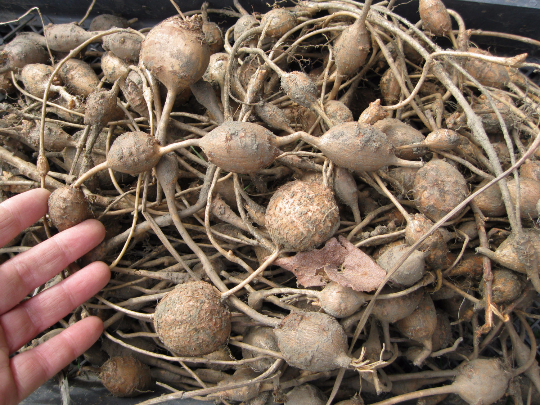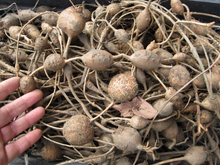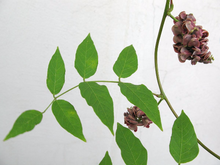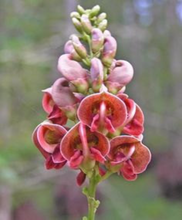Delicious Nutritious Easy to Grow Hopniss Tubers-Superfood-Survival Food-Apios americana-AKA American Groundnut-Indian potato bean-hodoimo
Regular price
$4.99
Sale
Apios americana, sometimes called the potato bean, hopniss, Indian potato, hodoimo, America-hodoimo, American groundnut,or groundnut (but not to be confused with other plants sometimes known by the name groundnut) is a perennial vine that bears edible beans and large Delicious edible tubers. Its vine can grow to 1–6 m long, with pinnate leaves 8–15 cm long with 5–7 leaflets. The flower are usually pink, purple, or red-brown, and are produced in dense racemes 7.5–13 cm in length. The fruit is a legume (pod) 5–13 cm long. Botanically speaking, the tubers are rhizomatous stems, not roots. Its natural range is from Southern Canada (including Ontario, Quebec, and New Brunswick) down through Florida and West as far as the border of Colorado.
They are often cooked as you would a potato. They can also be baked into chips or dried, and ground into a flour. The beans, foliage and flowers are also edible. The tubers are highly palatable with culinary characteristics of a potato, although the flavor can be somewhat nuttier than a potato and the texture can be finer. Tubers contain roughly three times the protein content of a potato (16.5% by dry weight), and the amino acid balance is good. The tubers are also an excellent source of calcium and iron. Calcium content is 10-fold greater than a potato and iron is 2-fold greater than a potato. The tuber and the flower are also full of mono and oligosaccharide. The tuber has more monosaccharides and oligosaccharides than the soybean, potato, and sweet potato.
The Europeans learned to use the American groundnut from the Native Americans. As a result, the American groundnut became interwoven with the history of the American colonies and Europe. The early traveler John Brereton was sustained by the “good meat” and “medicinable” qualities of American groundnut during his travels in New England in 1602. In 1613, the followers of Beincourt at Port Royal ate the tubers to help them live in the New World. The American groundnut was an important factor in the survival of the Pilgrims during the first few winters of their settlement. In 1623 the Pilgrims, “having but a small quantity of corn left,” were “enforced to live on groundnuts... and such other things that the country afforded... and were easily gotten...”. The Pilgrims were taught to find and prepare American groundnut by the Wampanoag people. It seems quite probable that groundnut would have been eaten at the harvest festival of November 1621 that is regarded as the first Thanksgiving.
American groundnut fixes its own nitrogen, which could be a great advantage in comparison to other roots crops, such as potatoes, true yams, and sweet potatoes, that do not fix their own nitrogen and require large nitrogen fertilizer inputs.
Plant tubers two to three inches deep anytime the soil can be worked. After shoots establishment in the spring, mulch to stop competition from weeds and grass. Provide the young shoots with a traverse or other objectives upon which to climb. After one year of growth, several tubers can be harvested from each plant. Tubers left in the ground will grow larger with 2-3 years being the sweet spot for highest yields. Will grow in a wide variety of conditions.
They are often cooked as you would a potato. They can also be baked into chips or dried, and ground into a flour. The beans, foliage and flowers are also edible. The tubers are highly palatable with culinary characteristics of a potato, although the flavor can be somewhat nuttier than a potato and the texture can be finer. Tubers contain roughly three times the protein content of a potato (16.5% by dry weight), and the amino acid balance is good. The tubers are also an excellent source of calcium and iron. Calcium content is 10-fold greater than a potato and iron is 2-fold greater than a potato. The tuber and the flower are also full of mono and oligosaccharide. The tuber has more monosaccharides and oligosaccharides than the soybean, potato, and sweet potato.
The Europeans learned to use the American groundnut from the Native Americans. As a result, the American groundnut became interwoven with the history of the American colonies and Europe. The early traveler John Brereton was sustained by the “good meat” and “medicinable” qualities of American groundnut during his travels in New England in 1602. In 1613, the followers of Beincourt at Port Royal ate the tubers to help them live in the New World. The American groundnut was an important factor in the survival of the Pilgrims during the first few winters of their settlement. In 1623 the Pilgrims, “having but a small quantity of corn left,” were “enforced to live on groundnuts... and such other things that the country afforded... and were easily gotten...”. The Pilgrims were taught to find and prepare American groundnut by the Wampanoag people. It seems quite probable that groundnut would have been eaten at the harvest festival of November 1621 that is regarded as the first Thanksgiving.
American groundnut fixes its own nitrogen, which could be a great advantage in comparison to other roots crops, such as potatoes, true yams, and sweet potatoes, that do not fix their own nitrogen and require large nitrogen fertilizer inputs.
Plant tubers two to three inches deep anytime the soil can be worked. After shoots establishment in the spring, mulch to stop competition from weeds and grass. Provide the young shoots with a traverse or other objectives upon which to climb. After one year of growth, several tubers can be harvested from each plant. Tubers left in the ground will grow larger with 2-3 years being the sweet spot for highest yields. Will grow in a wide variety of conditions.




